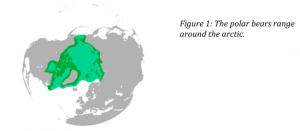
Everyone loves those cute cuddly polar bears that we see on TV commercials that look like the most harmless white puffballs. Well unfortunately, that portrayal is far from the truth. Polar bears are the largest terrestrial carnivores alive today and have some extreme adaptations to their extreme environment. Unfortunately, this extreme environment, the arctic, is losing much of its ice that is the polar bears prime hunting ground and habitat. Luckily polar bear international has installed International Polar Bear Day on February 27th so that we can all save our furry friends.
The Basics
Like stated before Ursus maritimus, the polar bear, is the largest land carnivore alive today, males can weigh up to 1,760 pounds! These ferocious predators live all around the arctic on the annual ice near the mainland during the winter months then during summer months head to the land where they rest and wait for the ice to reform (Figure1). Polar bears mate from late March to late May and give birth from November to January about every three years. Polar bears are mostly solitary except for females with their cubs. They are almost strictly carnivorous feeding on ringed and bearded seals.
The Hunting
- maritimus is one of the most radical hunters on the entire planet. These extreme predators rely on the sea ice to catch their prey. Ringed seals, their preferred prey, carve breathing holes through the ice so they can catch a breathe after diving for their own hunting treks. The polar bears have adapted to recognizing these breathing holes by sniffing them out with their powerful sense of smell and waiting for the unsuspecting seal to pop up. They have to be incredibly patient and wait for hours to days before they get their meal. Another tactic is the sneak-up approach. Polar bears rely on their white coat to sneak up on the seal, freezing in place whenever the seal raises its head. Then once they are close enough, about 20 feet away, they use their explosive speed and suction cup like paws to skate on the ice and pounce on their blubbery feast.
Interesting Adaptations
Believe it or not polar bears fur is not actually white. Their fur coat is incredibly dense and each hair is pigment-free and transparent with a hollow core that reflects visible light similar to the white snow or ice. Their fur is actually so dense that adult males can quickly overheat when running on land. Under their pigment-free fur they have black skin covering a thick layer of blubber to keep them warm in water. Their paws they have suction cup like holes that prevent slippage on the ice. Their front paws are also very large and paddle like so they can swim very well! (Figure 2)
 Dangers to Polar Bears
Dangers to Polar Bears
Polar bears heavily rely on sea ice to hunt during the winter months and struggle when there isn’t any ice to find and catch prey. With global climate change warming the earth more and more sea ice is disappearing creating huge difficulties to polar bears survival. This forces polar bears to swim long distances to find food essentially exhausting them and making their lives a whole lot harder
What Can You Do?!
International Polar Bear Day is designed to build awareness to our incredible furry friends. Polar Bear International is urging you to lower your thermostat to lower your carbon emissions and make less of an impact that day and into the future. To spread the word post a picture of you lowering your thermostat or cuddling up under some blankets with #PolarBearDay #ThermostatChallenge and #Hygge the Danish word for coziness! So embrace your inner polar bear and put on a dense fur coat while your lowering your thermostat to help save our wonderfully beautiful bear friends.


